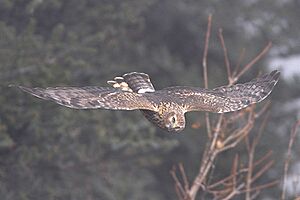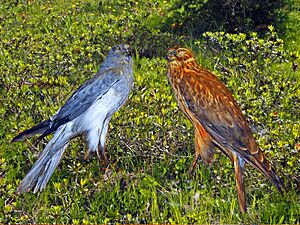Hen harrier facts for kids
Quick facts for kids Hen harrier |
|
|---|---|
 |
|
| Adult male | |
 |
|
| An adult female from Pangolakha Wildlife Sanctuary, East Sikkim, India | |
| Conservation status | |
| Scientific classification | |
| Genus: |
Circus
|
| Species: |
cyaneus
|
 |
|
| Range of C. cyaneus Breeding summer visitor Breeding resident Winter visitor | |
| Synonyms | |
|
Falco cyaneus Linnaeus, 1766 |
|
The Hen Harrier (Circus cyaneus) is a type of bird of prey, also known as a raptor. It lives and breeds across Europe and Asia. Its name comes from a time when it often hunted chickens that roamed freely.
These birds are migratory. This means they fly to warmer places for winter. Hen Harriers from Europe and Asia often move to southern Europe and parts of Asia. In places with mild winters, like France and Great Britain, some Hen Harriers stay all year. However, they usually leave higher, colder areas during winter.
Scientists used to think the Northern Harrier (found in North America) was the same species as the Hen Harrier. Now, they are considered two different species.
Contents
Naming the Hen Harrier
Scientists give every living thing a special two-part name. This helps everyone around the world know exactly which animal or plant they are talking about. This system is called taxonomy.
In 1766, a famous Swedish scientist named Carl Linnaeus gave the Hen Harrier its first scientific name, Falco cyaneus. He placed it in the Falco group, which includes falcons and eagles.
Later, in 1799, another scientist moved the Hen Harrier to a different group called Circus. This name comes from an old Greek word, kirkos, which means "circle." It refers to how these birds often fly in circles. The second part of its name, cyaneus, is Latin for "dark blue," describing the male bird's color.
The Hen Harrier is a single species, meaning it does not have different subspecies (smaller groups within a species).
What Does a Hen Harrier Look Like?

Hen Harriers are medium-sized birds. They are about 41–52 cm (16–20 in) long. Their wings can spread wide, from 97–122 cm (38–48 in) across.
Male and female Hen Harriers look quite different. This is called sexual dimorphism.
- Males are mostly grey on top and white underneath. Their wings are grey with black tips. They weigh around 350 g (12 oz).
- Females are brown on top. They have white feathers just above their tail, which is why they are sometimes called "ringtails." Their undersides are pale with brown streaks. Females are larger, weighing about 530 g (19 oz).
Young Hen Harriers look similar to females.
Hen Harriers also make different sounds. The female makes a whistling sound, piih-eh, when the male brings her food. Her alarm call sounds like chit-it-it-it-it-et-it. The male calls chek-chek-chek or a bouncy chuk-uk-uk-uk during his special display flight.
Hen Harrier Behavior
These birds of prey live in open areas. You can find them in moorlands, bogs, prairies, farmland, marshes, and grasslands. A male Hen Harrier usually looks after a large area, about 2.6 km2 (1.0 sq mi).
Reproduction and Family Life
Hen Harriers are one of the few raptors that practice polygyny. This means one male can mate with several females. Sometimes, a single male might have up to five female partners in one breeding season. Studies have shown that if there is more food available, males might have more breeding females.
The nest is built on the ground. It is often hidden in tall grass or on a small mound. Nests are made of sticks and lined with soft grass and leaves. Females usually lay four to eight whitish eggs.
The female does most of the incubation, sitting on the eggs for about 31 to 32 days. While she is on the nest, the male hunts and brings food to her. After the chicks hatch, the male helps feed them. He usually passes the food to the female, who then feeds it to the young birds.
Chicks are ready to fly, or fledge, when they are about 36 days old. Females can start breeding when they are two years old, and males usually start at three years old.
Hunting Style
Hen Harriers are skilled hunters. They fly low over the ground with their long wings held in a shallow 'V' shape. They hug the land's curves, surprising their prey.
Their diet is mostly small mammals, making up about 95% of what they eat. They also hunt birds regularly, especially the males. They catch small birds like sparrows and larks, young waterfowl, and game birds. Sometimes, they eat amphibians (like frogs), reptiles, and insects. They have even been seen hunting bats.
Hen Harriers have excellent hearing, like owls. This helps them find prey hidden in tall grass. They often circle an area, listening and looking carefully before swooping down.
Lifespan and Dangers
Hen Harriers usually live for about 8 years, though some have lived up to 16 years. Young birds face many dangers. Predators of eggs and chicks include raccoons, skunks, badgers, foxes, crows and ravens, dogs, and owls. Both parent birds will try to scare away predators with loud calls and by striking them with their talons.
Short-eared owls are natural rivals of Hen Harriers. They hunt similar prey and live in the same types of open habitats. Sometimes, these two birds will try to steal food from each other, a behavior called kleptoparasitism. Hen Harriers are usually the ones who try to steal from the owls.
Hen Harrier Status
The Hen Harrier lives across a very large area. Globally, its population is not considered to be in serious trouble. Therefore, the IUCN Red List classifies it as "least concern."
However, in some places like Britain and Ireland, Hen Harrier numbers are very low. This is mainly because of habitat loss and illegal killing. In England, there is enough good habitat for over 300 pairs of breeding Hen Harriers. But in 2022, only 34 nests were successful. Many young birds also do not survive their first year. Even in Scotland, where most UK Hen Harriers live, their population dropped by 27% between 2004 and 2016.
Hen Harriers and People
In the past, some people in Europe had strange beliefs about Hen Harriers. They thought seeing one perched on a house meant three people would die.
However, farmers often liked Hen Harriers. Unlike some other hawks, Hen Harriers usually do not hunt farm animals like chickens. Instead, they eat mice and other small animals that can harm crops. Because of this, Hen Harriers were sometimes called "good hawks."
Forests and Hen Harriers
Hen Harriers prefer open spaces like moorland and farmland. But in places like Ireland and parts of western Britain, many forests have been planted. These are often non-native trees like Sitka spruce.
Hen Harriers can use these new forests when the trees are young, before they grow too tall and dense (usually under 9-12 years old). They can nest and hunt there. However, once the trees grow taller and the forest becomes thick, Hen Harriers do not use these areas much. These older forests make up most of the commercial tree-growing cycle.
If new forests replace the open habitats that Hen Harriers used to live in, it can reduce the overall space available for them. But if forests are planted in areas where Hen Harriers did not live much before, it might actually help them in the long run. For Hen Harriers to thrive in forested areas, there needs to be a mix of different tree ages. This way, there are always some areas of young, open forest for them to use.
Images for kids




